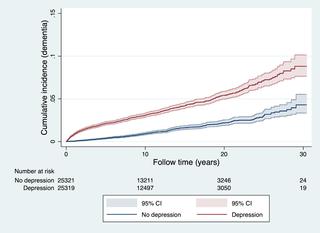Our official English website, www.x-mol.net, welcomes your feedback! (Note: you will need to create a separate account there.)
The association of depression with subsequent dementia diagnosis: A Swedish nationwide cohort study from 1964 to 2016.
PLOS Medicine ( IF 15.8 ) Pub Date : 2020-01-09 , DOI: 10.1371/journal.pmed.1003016 Sofie Holmquist 1, 2 , Anna Nordström 1, 3 , Peter Nordström 4
PLOS Medicine ( IF 15.8 ) Pub Date : 2020-01-09 , DOI: 10.1371/journal.pmed.1003016 Sofie Holmquist 1, 2 , Anna Nordström 1, 3 , Peter Nordström 4
Affiliation

|
BACKGROUND
Depression is associated with an increased risk of dementia. However, short follow-up times and lack of adjustment for familial factors in previous studies could influence this association. The purpose of the present study was to investigate the association between depression and subsequent dementia, while controlling for familial factors and with a follow-up of over 35 years.
METHODS AND FINDINGS
Two cohorts were formed from all individuals aged 50 years or older living in Sweden as of 31 December 2005 (n = 3,341,010). The Swedish National Patient Register was searched from 1964 through 2016 to identify diagnosis of depression and dementia. In the first cohort, individuals diagnosed with depression (n = 119,386) were matched 1:1 with controls without depression diagnosis. The second cohort was a sibling cohort (n = 50,644) consisting of same-sex full sibling pairs with discordant depression status. In the population matched cohort study, a total of 9,802 individuals were diagnosed with dementia during a mean follow-up time of 10.41 (range 0-35) years (5.5% of those diagnosed with depression and 2.6% of those without depression diagnosis (adjusted odds ratio [aOR] 2.47, 95% CI 2.35-2.58; p < 0.001), with a stronger association for vascular dementia (aOR 2.68, 95% CI 2.44-2.95; p < 0.001) than for Alzheimer disease (aOR 1.79, 95% CI 1.68-1.92; p < 0.001). The association with dementia diagnosis was strongest in the first 6 months after depression diagnosis (aOR 15.20, 95% CI 11.85-19.50; p < 0.001), then decreased rapidly but persisted over follow-up of more than 20 years (aOR 1.58, 95% CI 1.27-1.98; p < 0.001). Also in the sibling cohort, the association was strongest in the first 6 months (aOR 20.85, 95% CI 9.63-45.12; p < 0.001), then decreased rapidly but persisted over follow-up of more than 20 years (aOR 2.33, 95% CI 1.32-4.11; p < 0.001). The adjusted models included sex, age at baseline, citizenship, civil status, household income, and diagnoses at baseline. The main limitation of the study methodology is the use of observational data; hence, the associations found are not proof of causal effects.
CONCLUSIONS
Depression is associated with increased odds of dementia, even more than 20 years after diagnosis of depression, and the association remains after adjustment for familial factors. Further research is needed to investigate whether successful prevention and treatment of depression decrease the risk of dementia.
中文翻译:

抑郁与随后的痴呆症诊断的关联:1964年至2016年瑞典全国范围的队列研究。
背景技术抑郁症与痴呆的风险增加相关。但是,较短的随访时间和先前研究中缺乏家庭因素的调整都可能影响这种关联。本研究的目的是调查抑郁症和随后的痴呆症之间的关联,同时控制家族因素并进行超过35年的随访。方法和结果截至2005年12月31日,居住在瑞典的所有50岁以上的个体组成了两个队列(n = 3,341,010)。从1964年至2016年对瑞典国家患者登记簿进行了搜索,以鉴定抑郁症和痴呆症的诊断。在第一个队列中,被诊断为抑郁症的患者(n = 119,386)与没有抑郁症诊断的对照组为1:1匹配。第二组是同级组(n = 50,644)由同性完整同胞对组成,抑郁状态不协调。在人群匹配队列研究中,在平均随访时间为10.41(0-35)年内,共诊断出9 802名痴呆症患者(5.5%诊断为抑郁症和2.6%未诊断为抑郁症(校正后)比值比[aOR] 2.47,95%CI 2.35-2.58; p <0.001),与阿尔茨海默病(aOR 1.79,95)相比,血管性痴呆的关联性更强(aOR 2.68,95%CI 2.44-2.95; p <0.001) %CI 1.68-1.92; p <0.001)。与抑郁症诊断相关的关联在抑郁症诊断后的前6个月中最强(aOR 15.20,95%CI 11.85-19.50; p <0.001),然后迅速下降,但在随访后一直持续超过20年(aOR 1.58,95%CI 1.27-1.98; p <0.001)。在同胞队列中,关联在最初的6个月中最强(aOR 20.85,95%CI 9.63-45.12; p <0.001),然后迅速下降,但在随访20年以上一直持续(aOR 2.33,95%CI 1.32-4.11; p <0.001)。调整后的模型包括性别,基线年龄,公民身份,公民身份,家庭收入和基线诊断。研究方法的主要局限性是使用观测数据。因此,发现的关联不是因果关系的证据。结论抑郁症与痴呆的几率增加有关,甚至在诊断为抑郁症后20年以上,并且在调整了家庭因素后这种关联仍然存在。需要进一步研究以调查成功的抑郁症预防和治疗是否可以降低痴呆症的风险。95%CI 9.63-45.12; p <0.001),然后迅速下降,但在随访20余年中持续存在(aOR 2.33,95%CI 1.32-4.11; p <0.001)。调整后的模型包括性别,基线年龄,公民身份,公民身份,家庭收入和基线诊断。研究方法的主要局限性是使用观测数据。因此,发现的关联不是因果关系的证据。结论抑郁症与痴呆的几率增加有关,甚至在诊断为抑郁症后20年以上,并且在调整了家庭因素后这种关联仍然存在。需要进一步研究以调查成功的抑郁症预防和治疗是否可以降低痴呆症的风险。95%CI 9.63-45.12; p <0.001),然后迅速下降,但在随访20余年中持续存在(aOR 2.33,95%CI 1.32-4.11; p <0.001)。调整后的模型包括性别,基线年龄,公民身份,公民身份,家庭收入和基线诊断。研究方法的主要局限性是使用观测数据。因此,发现的关联不是因果关系的证据。结论抑郁症与痴呆的几率增加有关,甚至在诊断为抑郁症后20年以上,并且在调整了家庭因素后这种关联仍然存在。需要进一步研究以调查成功的抑郁症预防和治疗是否可以降低痴呆症的风险。95%CI 1.32-4.11; p <0.001)。调整后的模型包括性别,基线年龄,公民身份,公民身份,家庭收入和基线诊断。研究方法的主要局限性是使用观测数据。因此,发现的关联不是因果关系的证据。结论抑郁症与痴呆的几率增加有关,甚至在诊断为抑郁症后20年以上,并且在调整了家庭因素后这种关联仍然存在。需要进一步研究以调查成功的抑郁症预防和治疗是否可以降低痴呆症的风险。95%CI 1.32-4.11; p <0.001)。调整后的模型包括性别,基线年龄,公民身份,公民身份,家庭收入和基线诊断。研究方法的主要局限性是使用观测数据。因此,发现的关联不是因果关系的证据。结论抑郁症与痴呆的几率增加有关,甚至在诊断为抑郁症后20年以上,并且在调整了家庭因素后这种关联仍然存在。需要进一步研究以调查成功的抑郁症预防和治疗是否可以降低痴呆症的风险。因此,发现的关联不是因果关系的证据。结论抑郁症与痴呆的几率增加有关,甚至在诊断为抑郁症后20年以上,并且在调整了家庭因素后这种关联仍然存在。需要进一步研究以调查成功的抑郁症预防和治疗是否可以降低痴呆症的风险。因此,发现的关联不是因果关系的证据。结论抑郁症与痴呆的几率增加有关,甚至在诊断为抑郁症后20年以上,并且在调整了家庭因素后这种关联仍然存在。需要进一步研究以调查成功的抑郁症预防和治疗是否可以降低痴呆症的风险。
更新日期:2020-01-10
中文翻译:

抑郁与随后的痴呆症诊断的关联:1964年至2016年瑞典全国范围的队列研究。
背景技术抑郁症与痴呆的风险增加相关。但是,较短的随访时间和先前研究中缺乏家庭因素的调整都可能影响这种关联。本研究的目的是调查抑郁症和随后的痴呆症之间的关联,同时控制家族因素并进行超过35年的随访。方法和结果截至2005年12月31日,居住在瑞典的所有50岁以上的个体组成了两个队列(n = 3,341,010)。从1964年至2016年对瑞典国家患者登记簿进行了搜索,以鉴定抑郁症和痴呆症的诊断。在第一个队列中,被诊断为抑郁症的患者(n = 119,386)与没有抑郁症诊断的对照组为1:1匹配。第二组是同级组(n = 50,644)由同性完整同胞对组成,抑郁状态不协调。在人群匹配队列研究中,在平均随访时间为10.41(0-35)年内,共诊断出9 802名痴呆症患者(5.5%诊断为抑郁症和2.6%未诊断为抑郁症(校正后)比值比[aOR] 2.47,95%CI 2.35-2.58; p <0.001),与阿尔茨海默病(aOR 1.79,95)相比,血管性痴呆的关联性更强(aOR 2.68,95%CI 2.44-2.95; p <0.001) %CI 1.68-1.92; p <0.001)。与抑郁症诊断相关的关联在抑郁症诊断后的前6个月中最强(aOR 15.20,95%CI 11.85-19.50; p <0.001),然后迅速下降,但在随访后一直持续超过20年(aOR 1.58,95%CI 1.27-1.98; p <0.001)。在同胞队列中,关联在最初的6个月中最强(aOR 20.85,95%CI 9.63-45.12; p <0.001),然后迅速下降,但在随访20年以上一直持续(aOR 2.33,95%CI 1.32-4.11; p <0.001)。调整后的模型包括性别,基线年龄,公民身份,公民身份,家庭收入和基线诊断。研究方法的主要局限性是使用观测数据。因此,发现的关联不是因果关系的证据。结论抑郁症与痴呆的几率增加有关,甚至在诊断为抑郁症后20年以上,并且在调整了家庭因素后这种关联仍然存在。需要进一步研究以调查成功的抑郁症预防和治疗是否可以降低痴呆症的风险。95%CI 9.63-45.12; p <0.001),然后迅速下降,但在随访20余年中持续存在(aOR 2.33,95%CI 1.32-4.11; p <0.001)。调整后的模型包括性别,基线年龄,公民身份,公民身份,家庭收入和基线诊断。研究方法的主要局限性是使用观测数据。因此,发现的关联不是因果关系的证据。结论抑郁症与痴呆的几率增加有关,甚至在诊断为抑郁症后20年以上,并且在调整了家庭因素后这种关联仍然存在。需要进一步研究以调查成功的抑郁症预防和治疗是否可以降低痴呆症的风险。95%CI 9.63-45.12; p <0.001),然后迅速下降,但在随访20余年中持续存在(aOR 2.33,95%CI 1.32-4.11; p <0.001)。调整后的模型包括性别,基线年龄,公民身份,公民身份,家庭收入和基线诊断。研究方法的主要局限性是使用观测数据。因此,发现的关联不是因果关系的证据。结论抑郁症与痴呆的几率增加有关,甚至在诊断为抑郁症后20年以上,并且在调整了家庭因素后这种关联仍然存在。需要进一步研究以调查成功的抑郁症预防和治疗是否可以降低痴呆症的风险。95%CI 1.32-4.11; p <0.001)。调整后的模型包括性别,基线年龄,公民身份,公民身份,家庭收入和基线诊断。研究方法的主要局限性是使用观测数据。因此,发现的关联不是因果关系的证据。结论抑郁症与痴呆的几率增加有关,甚至在诊断为抑郁症后20年以上,并且在调整了家庭因素后这种关联仍然存在。需要进一步研究以调查成功的抑郁症预防和治疗是否可以降低痴呆症的风险。95%CI 1.32-4.11; p <0.001)。调整后的模型包括性别,基线年龄,公民身份,公民身份,家庭收入和基线诊断。研究方法的主要局限性是使用观测数据。因此,发现的关联不是因果关系的证据。结论抑郁症与痴呆的几率增加有关,甚至在诊断为抑郁症后20年以上,并且在调整了家庭因素后这种关联仍然存在。需要进一步研究以调查成功的抑郁症预防和治疗是否可以降低痴呆症的风险。因此,发现的关联不是因果关系的证据。结论抑郁症与痴呆的几率增加有关,甚至在诊断为抑郁症后20年以上,并且在调整了家庭因素后这种关联仍然存在。需要进一步研究以调查成功的抑郁症预防和治疗是否可以降低痴呆症的风险。因此,发现的关联不是因果关系的证据。结论抑郁症与痴呆的几率增加有关,甚至在诊断为抑郁症后20年以上,并且在调整了家庭因素后这种关联仍然存在。需要进一步研究以调查成功的抑郁症预防和治疗是否可以降低痴呆症的风险。


























 京公网安备 11010802027423号
京公网安备 11010802027423号